| By Alice B. Yeager Fall winds down with the ripening of a Japanese persimmon known as the Fuyugaki variety. |
 |
| Issue #104 • March/April, 2007 |
There’s not one of us who doesn’t like fruit of some kindapples, pears, peaches, you name it. We relish fresh fruit, but we also make all kinds of pies, cakes, and preserves using fruit. If it comes from our own trees, we can count ourselves among the fortunate.
We gardeners derive a great deal of pleasure from harvesting “the fruits of our labor,” particularly those that come from a tree we have planted and tended ’til it yields its first crop. That harvest is special even if it’s small. At least, we get an inkling of taste, quality, and performance to comeor not.
|
Barring any kind of disaster, we look forward to the next year’s crop, and so on. Good fruit fresh from one’s own premises is of great value in more ways than one. Not only is home-grown fruit desirable from a health standpoint, but there’s a personal feeling of accomplishment in knowing we can actually grow our own fruit. A cozy feeling of well being comes from looking at jars of preserves and other good things sitting on pantry shelves or tucked away in freezer bags.
Regarding fruit shipped in from distant orchards or from foreign sources, there’s always the suspicion of harmful sprays having been used to quell some type of disease or insect. If we grow our own trees, we may have some problems, but at least we know what we have used to try to solve them. This is where a visit to our County Extension Agent may pay off as that person will know whether or not certain fruit trees will succeed in our area, and we can obtain advice on caring for our trees.
It pays to be mindful of drawbacks when planting fruit trees. In southwestern Arkansas, Zone 8, our summers are often drought-prone with extended periods of high humidity and temperatures hovering in the upper 90s or above. Some varieties of pear and apple trees, as well as others, do not thrive in our climate. Plant those farther north in cooler areas and they’ll be with you for a long time, becoming better assets as the years roll by.
Anyone selecting fruit trees for orchards or maybe a tree or two for a home garden should pay attention to USDA Hardiness Zone Maps shown in nursery catalogs and on page 11. Generally speaking, trees listed as suitable for Zones 5-7 will not amount to much in Zones 8-10 unless they are planted in the higher and cooler sections of those zones. Inasmuch as we live close to Zone 9, I am inclined to favor buying trees that include Zone 9 in their description, as they seem more able to cope with our climate.
Periods of heat and high humidity foster a menace known as fire blight, which is an ever-present threat to many fruit trees as well as certain shrubs. The blight may be controlled by diligently following a spraying program if one has only a few trees and has the time and stamina to watch over them closely. This disease is a tough customer, as it can be spread by rain and a number of insects, including honey bees. The bacteria can also winter-over by forming a canker underneath bark, beginning its cycle of destruction again the next spring.
|
It is essential that we pay attention to “fire blight resistant” when checking out descriptions of various fruit trees in nursery catalogs. In the case of pear trees, if the description does not include something about fire blight, beware. For instance, some nurseries listing the Bartlett pear tree do not state that these trees are highly susceptible to fire blight. Instead, they dwell on the delicious quality of the fruit and the fact that the trees are very productive. After all, the Bartletts have been available for more than 200 years and are considered the peak of perfection where pears are concerned. What could possibly go wrong?
For starters, Bartlett pear trees like the cool humidity found in the North from New England to Michigan and out on the Pacific Coast. In these areas where there are lakes and streams large enough to provide plenty of humidity, the Bartletts do well. Planted in the hot, humid south, they are almost certain to be done in by fire blight.
Inexperienced gardeners often select fruit trees, such as Bartletts, and find them to be completely incompatible with their growing conditions. These trees do not always come from nursery catalogs. Many of them are bought from superstore garden areas where the public may purchase all manner of trees, shrubs, and flowers, particularly during spring when gardening enthusiasm reigns supreme. Salespeople, who often are not gardeners themselves, are there to sell and not to give gardening information other than what is stated on labels.
Folks wanting to have their own pear trees should not give up, however, as there are pear trees that will succeed where Bartletts fail. They may not have the delicious quality of the Bartlett, but they produce outstanding crops of pears suitable for salads and canning. An old variety of pear that is often seen still producing around abandoned home sites is the Kieffer. No fire blight there. Pears ripen in late summer and are excellent for preserving and pear honey. If pears are picked while firm and laid on a shelf to ripen, one can hardly ask for more in delicious old-time flavor.
|
Many nurseries now offer Asian varieties of pears that seem to be more resistant to fire blight than the European varieties. However, it still pays to read the descriptions very closely as some trees are more disease-resistant than others. Another bit of advicelook around your neighborhood and take notice of trees that have produced substantial yields for years without a great many problems. Ask questions of owners so that you’ll be armed with good local information when you select your own trees. Pear trees usually bear their first fruit within 3-4 years.
Apple trees are often foremost in a gardener’s mind when thinking about planting fruit trees. If you have ever caught the aroma of a freshly baked apple pie cooling on a kitchen table, it’s hard not to put apple trees on a preferred list. However, not all apples are suitable for pies. One needs a firm apple such as Granny Smith or Jonathan. Apples with good eating quality, but not as firm, will still give a good account of themselves when made into applesauce or cider.
Like all fruit trees, certain varieties of apple trees do better in northern zones than in the south. Apple orchards will be found in southern mountainous areas such as northern Arkansas, but apple trees are not known to thrive in hot humid regions farther south.
Some varieties of apple trees are highly subject to cedar apple rust, mildew, scab, and the infamous fire blight, so it is imperative to know the shortcomings of any variety you desire to plant. For instance, a lot of us love the taste and texture of a Golden Delicious apple. Trees are said to have good rust resistance, but this is a variety that produces best in a cool climate.
|
Not all fruit trees are self-fertile, which means that they do not need other trees of the same variety nearby to set fruit. It is well to find out if you need more than one variety for pollination, and most nursery catalogs will state this fact in their descriptions. Some varieties will never yield a decent amount of fruit unless there is a tree known as a pollinator nearby. Regarding apple trees, Golden Delicious is listed as a good pollinator, along with others including Granny Smith. Apple trees, on the average, should flower and bear within 3-4 years.
It would be hard to find a more luscious fruit than an Elberta peach. This is an old variety of peach and not as resistant to disease as some of our newer types. Years ago, there were lots of peach orchards around Nashville, Arkansas, where peaches were definitely a prominent part of the economy. During peach season, peddlers used to come around with their trucks loaded with baskets of the fragrant fruit right out of the orchards. Folks in our area bought bushels of peaches to enjoy fresh and particularly to can. Some peach lovers even enjoyed going to the orchards and picking their own fruit.
Unfortunately, due mainly to weather problems and labor shortages, many of the Nashville orchards have been turned into cattle ranches. Others have contracted their peach crops to commercial harvesters, and we see no peddlers anymore. There are a few roadside stands left, but sometimes the folks manning them can’t tell us exactly where the peaches and other fruits have been grown.
Peaches such as the Elberta that are not good for shipping great distances can be grown very successfully in a home garden if located in a peach growing area in Zones 5-8. Elbertas are heavy producers, so it’s likely that one or two trees will be quite enough for family use. Most peach trees are self-pollinating, and bearing age is from 2-3 years depending on variety.
|
Most folks will want to can some of their peaches, so it might be well to take into consideration whether you want cling or freestone peaches. The cling peaches tend to have a firmer flesh that resists bruising, whereas the freestones are softer and have pits that are easier to remove than the cling pits. It’s a matter of taste and choice.
If any peach tree is heavily loaded with fruit, it is wise to thin fruit to be spaced 6-7 inches apart about 5-6 weeks after bloom stage. This will help preserve size and quality and help the struggling tree conserve its strength. Limbs that are too heavy with fruit are likely to break. If you suspect possible damage to a tree, begin early to install some props to relieve the weight.
One should definitely check with the local County Extension Agent regarding possible drawbacks when it comes to raising peaches. If a garden is located in a low area known as a frost pocket, planting peach trees is risky. The trees are very susceptible to frost damage, particularly when they are in a mild winter area. Flower buds tend to develop sooner than in a colder area and, if flower buds are damaged by spring frosts, there goes most of the cropor all of it.
Regarding pests and diseases, again it would be well to check with your Extension Agent to find out which ones are prevalent in your area. The peach tree borer seems to be widespread, and its presence is easily detected if brown gummy masses appear on the lower part of a tree. This is caused by the larval stage of a moth that lays its eggs in burrows at the base of the tree. Eggs hatch during summer. Larvae go under the bark, feeding until winter, and resume feeding the next spring and summer. Inasmuch as borers will kill trees, it’s essential to deal with them at once. I have found that sprinkling wood ashes from a fireplace around the base of fruit trees during dormancy is a good way to keep them free from borers.
If you are looking for a delectable fruit that ripens late in the season, try the Japanese persimmon known as Fuyugaki. These trees are being seen more and more in the American landscape as gardeners learn about them. There are a number of Asian varieties, but many of them have astringent fruit that has to be fully ripe before using.
|
Fuyugaki grows well in our area despite our summer handicaps. We don’t have to wait for a fall frost for persimmons to be edible as with native persimmons. Diospyros is the botanical name for the genus of these trees. It means “food for the gods” and is quite appropriate for Fuyugaki. First fruits may be harvested in 4-5 years, but it’s worth the wait.
Flat, tomato-shaped Fuyugaki fruits often weigh a pound apiece and are non-astringent. That means no mouth puckering if you bite into a fruit that is mature but not soft yet. Fruit will turn to a dark red with a blue blush and be slightly soft when ripe. Texture is good and juicy with a flavor all its own. Maybe there’s a slight taste resemblance to a native American persimmon. Surplus fruit may be pureed and canned or frozen to use in cakes and pies, much as you would use other pureed fruit. (Peel persimmons before pureeing.)
Pest problems seem to come mainly in the form of webworms or tent caterpillars. These should be dealt with as soon as they appear as they can defoliate trees in a hurry if not wiped out. A good method is to break into their webs while the caterpillars are all together inside and give them a puff of Sevin dust.
Trees I have mentioned here are but the tip of the iceberg where fruit trees are concerned, but these are among the most popular for home growing. All of them will thrive in good, well-drained, loamy garden soil in full sun. If space is limited, try dwarf trees. They will give a good account of themselves and not overshadow other plants.
Some gardeners have become experts at espaliering fruit trees against walls and fences, thereby making even more use of their limited space. Many nurseries list trees suitable for espaliering as well as columnar growing. If you know someone who is physically challenged and no longer able to tend a regular garden, these trees would make nice gifts as they can be placed on sunny patios or somewhere easily accessible for watering and care.
|
Pay attention to planting, growing, fertilizing, and pruning instructions that come with trees. Be familiar with diseases and harmful insects that are known to attack certain trees. Give your new trees extra root room when digging holes. Fill in around them with loose soil. No clods. Supply them with sufficient water throughout dry periods until they become established.
Plenty of TLC goes a long way with trees as well as other plants.
Syrup for canning fresh fruit
A simple syrup of sugar and water is recommended for canning most firm fruit such as apples and pears. Fruit should be well washed, peeled, and cut into desired pieces (halves, quarters, and so on).
Light syrup: 4 cups water, 2 cups sugar
Medium syrup: 4 cups water, 3 cups sugar
Heavy syrup: 4 cups water, 4¾ cups sugar
Combine water and sugar in a heavy saucepan, heat to boiling, and stir until sugar is dissolved. Keep syrup hot until used. Each pint jar will need about ½ cup syrup and each quart about ¾-1 cup syrup.
There are so many angles to canning fresh fruit that anyone desiring to do so should have a home canning guide handy. Ball’s Blue Book is very informative. Call 1-800-240-3340 and tell the Ball folks what you need to know and they’ll be glad to help you.
Pear honey
Peel and core hard ripe pears such as Kieffer pears. Soft pears are not suitable for this recipe.
Cut pears in chunks small enough to easily feed through food grinder fitted with coarse blade. To each quart of ground pears add the following:
3 cups sugar
juice of one lemon
grated rind of one-half lemon
½ tsp. ground ginger
Boil mixture in a stainless steel, porcelain, or graniteware pot, stirring frequently until thickened. (Do not use aluminum.) When desired thickness is achieved, immediately put into hot, sterilized jars and seal. Avoid overcooking as this is a spread and should not reach the jelly stage.
A tasty variation is to substitute orange and nutmeg for lemon and ginger.
Apple crisp
6-8 medium-size firm apples
1 cup sugar
½ cup butter or oleo
¾ cup unbleached flour
1 tsp. cinnamon
Wash apples and remove any blemishes. Quarter apples and discard cores. (It’s not necessary to peel apples.)
Place apples in a well-greased, 9-inch baking dish. Work rest of ingredients together with a pastry blender or fork until they form a coarse crumbly mixture. Pack mixture over apples. Bake 45 minutes to an hour at 350° F until apples are done and topping is golden brown.
Best served warm with perhaps a bit of whipped cream or Cool Whip.
Peach cobbler
Cobbler ingredients:
4 cups peeled, sliced fresh peaches
½ cup sugar
1½ Tbsp. cornstarch
1/3 cup brown sugar
½ cup water
1 Tbsp. butter or oleo
1 Tbsp. fresh lemon juice
1 Tbsp. sugar, reserved
Batter topping:
½ cup sifted flour
½ cup sugar
½ tsp. baking powder
¼ Tbsp. salt
2 Tbsp. soft butter or oleo
1 egg, slightly beaten
Combine and set aside the 4 cups of peaches and the ½ cup sugar for 15-20 minutes to let juices begin to form.
Mix cornstarch, brown sugar, and water together. Add peaches and cook in a heavy sauce pan until mixture thickens (about 15 minutes). Add butter and lemon juice. Pour into an 8-inch baking dish.
Combine all ingredients for batter topping and beat until batter is smooth. Drop by spoonfuls over hot peaches. (Batter will spread during baking.) Sprinkle with reserved 1 Tbsp. sugar. Bake in 375° F oven 40 to 45 minutes or until topping is golden brown.
Fuyugaki persimmon pie
1 unbaked 9-inch pie shell
½ cup sugar
2 Tbsp. flour
½ tsp. ginger
½ tsp. nutmeg
1½ cups pureed Fuyugaki pulp (do not puree skins)
¼ cup evaporated milk
1 egg, slightly beaten
1/3 cup chopped pecans (optional)
Sift dry ingredients together and combine with persimmon pulp. Add milk and egg. Stir until smooth and pour into unbaked pie shell. Bake at 375° F for 45-50 minutes or until knife inserted in center comes out clean.
Pie may be taken from oven just before completely done, sprinkled with chopped pecans (or other nuts), and returned to oven to finish baking.


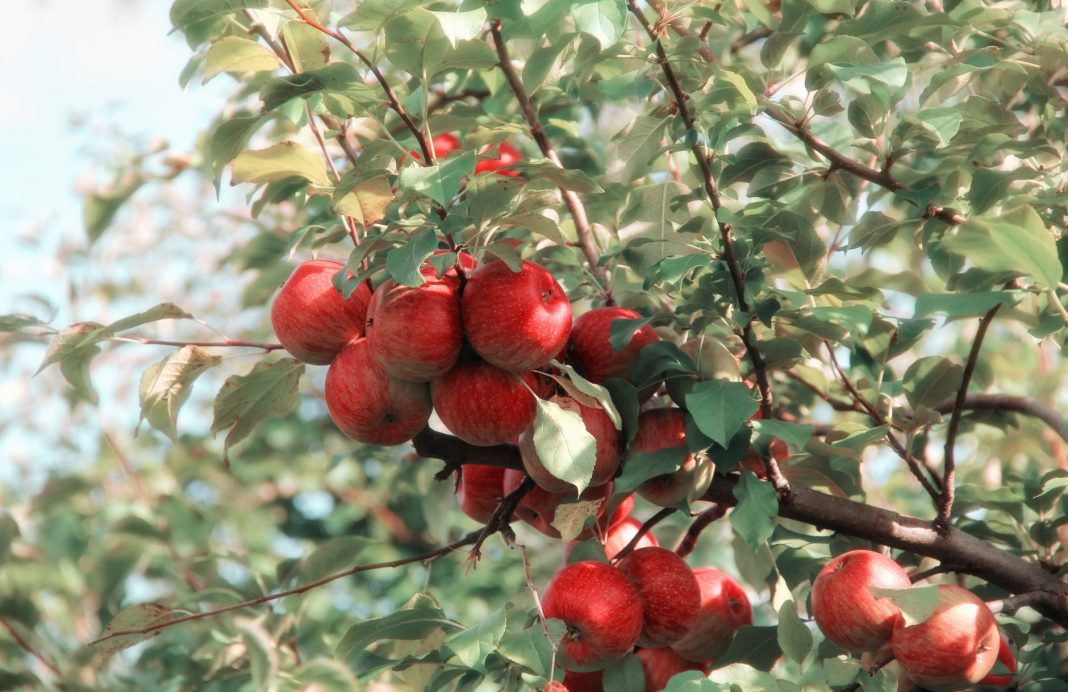







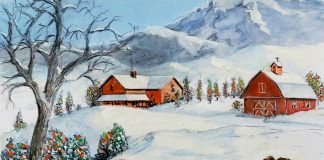
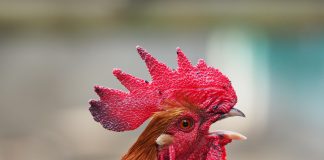




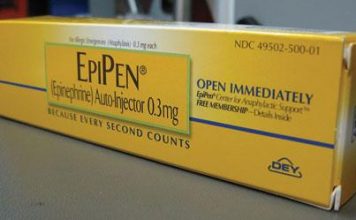
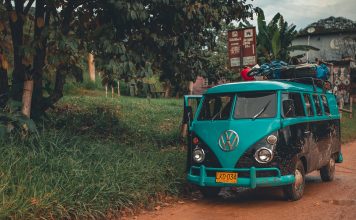
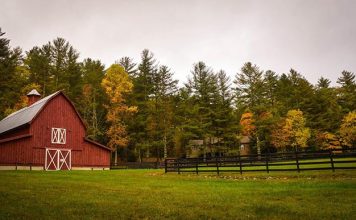
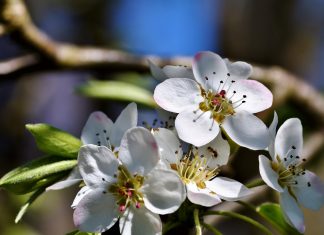
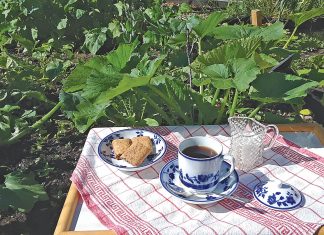
Also, it’s so simple to use water to can fruits. My pears, plums, and nectarines haven’t suffered any loss of flavor, whatsoever, and my body’s better off for it. After all, “food is to minister to the blood”.
Fortunately, nurseries in your local area sell only for your zone and you don’t have to send off across the country for bare-root trees. So you don’t have to study varieties so much, but it is pretty interesting. I have a Fuji that got fire blight. I then sprayed with a copper solution all my apple and pear trees (those are the most suseptible) for several seasons, then I just quit doing it. My trees with the blight and without the blight have thus grown for several more years producing just fine. Early on, I did prune extensively the one apple that was blighted. It’s grown large and productive, though funny shaped. It seems it will die, but only near it’s expectedly life span, anyway. Thanks for a good article.
Thank you for the recipe for Pear Honey. I grew up eating this and loved it. HopI can find Kieffer pears.